
The first circumstellar disk was discovered in another galaxy
An article published in the journal “Nature” reports the identification of a protoplanetary disk around the very young star cataloged as HH 1177 in the Large Magellanic Cloud, one of the dwarf galaxies satellite of the Milky Way. A team of researchers used the ALMA radio telescope to observe the disk in a follow-up study after observations conducted with the MUSE instrument mounted on the VLT allowed to see jets coming from the still-forming star. This is the first detection of a circumstellar disk in another galaxy. That type of structure is also called a Keplerian disk in jargon because it obeys the same laws as planetary motion.





